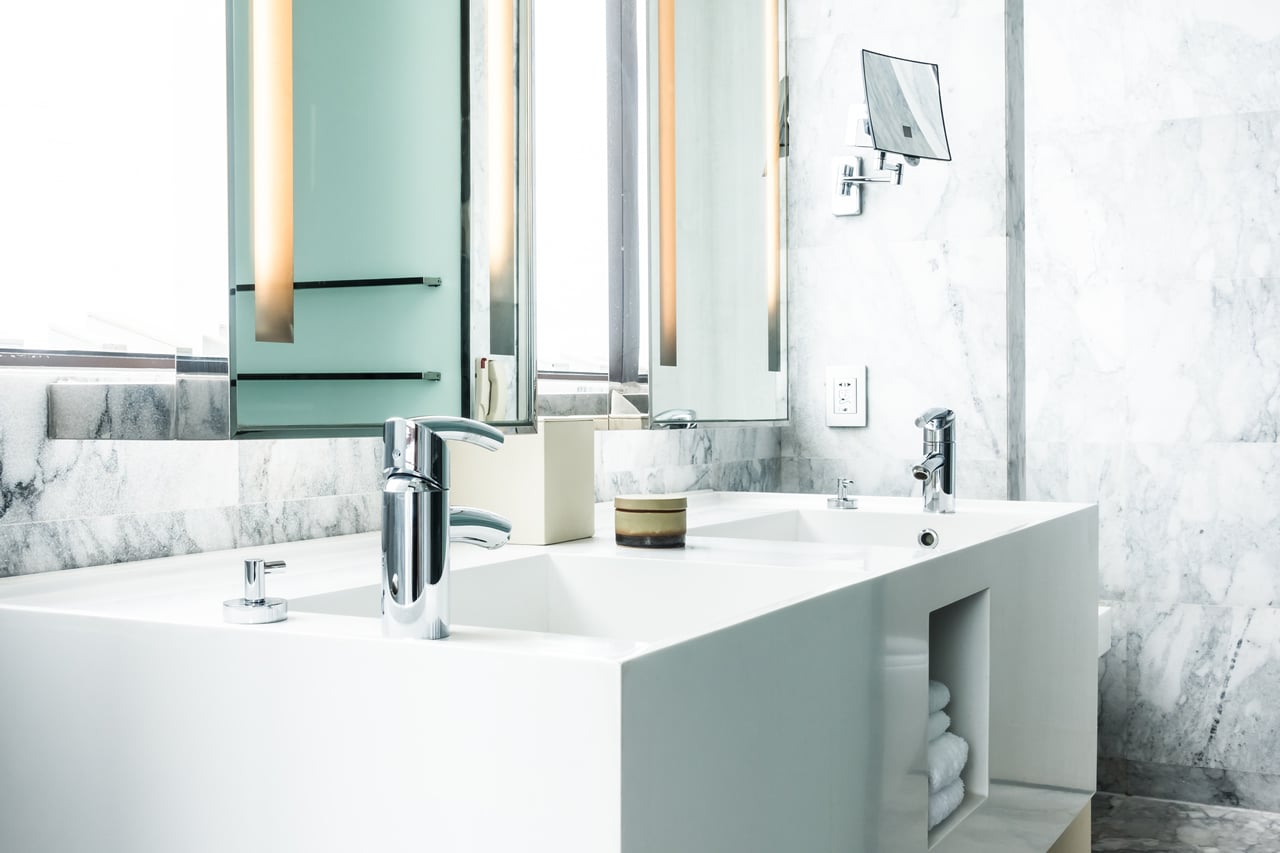Understanding Bathroom Fitting Services
Before delving into the process of selecting and working with professional bathroom fitters, it’s important to comprehend what bathroom fitting entails and the role of a professional fitter in this process.
What is Bathroom Fitting?
Bathroom fitting, also known as bathroom installation, is a comprehensive process that involves the installation or renovation of various components in a bathroom. These elements may include plumbing fixtures like bathtubs, showers, sinks, and toilets, as well as other elements like cabinets, mirrors, and tiles.
This process can be as simple as replacing a few fixtures or as complex as a complete overhaul of the entire bathroom, involving structural changes and redesigns. Regardless of the scale, bathroom fitting requires a great deal of planning, expertise, and precision to ensure the end result is both functional and aesthetically pleasing. For more details on what to expect during this process, you can refer to our article What to Expect During the Bathroom Installation Process.
The Role of a Professional Bathroom Fitter
A professional bathroom fitter is a skilled tradesperson who specializes in the installation and renovation of bathrooms. Their role is multifaceted, encompassing everything from initial consultation and design planning to the physical installation of bathroom fixtures and finishing touches.
Professional fitters have the expertise to handle a variety of tasks, including plumbing, tiling, carpentry, and electrical work. They also manage any unexpected issues that may arise during the fitting process, such as structural problems or plumbing complications.
In addition to their practical skills, professional bathroom fitters also offer design advice and guidance, helping clients to choose fixtures, layouts, and styles that best suit their needs and preferences. They ensure that the project stays on schedule and within the set budget, delivering a final product that meets the client’s expectations in terms of functionality, quality, and design.
Hiring a professional fitter takes the stress and guesswork out of the bathroom fitting process, ensuring that the project is completed to a high standard. For more information on the benefits of hiring a professional fitter, check out our article on Bathroom Installation: DIY vs. Professional Fitters.
In the following sections of this guide, we will delve deeper into the process of bathroom fitting, offering insights on how to select a reliable fitting service, prepare for a bathroom fitting project, and overcome common challenges. Stay tuned to learn more about the intricacies of professional bathroom fitting services.
The Process of Bathroom Fitting
The process of professional bathroom fitting services involves several stages, each contributing to the successful completion of the project. Understanding each phase can help you prepare and adapt to the changes that will occur in your home.
Initial Consultation and Design
The first step in any bathroom fitting project is the initial consultation and design phase. Here, you’ll discuss your ideas, preferences, and requirements with the bathroom fitter. Based on your inputs, the fitter will then create a design plan that includes the layout, fixtures, and finishes for your new bathroom.
This phase allows you to visualize the final result and make any necessary adjustments before the actual work begins. For more insights into what to expect during this phase, visit our article on what to expect during the bathroom installation process.
Demolition and Removal
Once the design has been finalized, the next step is demolition and removal. This involves removing the existing fixtures, flooring, and wall coverings to make way for the new design. The bathroom fitter will ensure that the work is carried out safely and efficiently, minimizing disruption to your home.
During this phase, it’s important to have a temporary alternative arrangement for bathroom facilities, as your current bathroom will be out of service. For a deeper understanding of the challenges involved in this phase and how to overcome them, take a look at our article on common challenges in bathroom installation and how to overcome them.
Installation and Fitting
The installation and fitting phase is the heart of the bathroom fitting process. Here, the fitter will install the new fixtures, fittings, and finishes according to the agreed-upon design plan.
The installation process needs to be meticulous and precise, ensuring that everything from the plumbing and electrical connections to the alignment of fixtures is perfect. This is where the expertise of a professional fitter is invaluable. To understand the importance of professional fitting services, read our article on bathroom installation: diy vs. professional fitters.
Finishing Touches
The final phase of the bathroom fitting process is the finishing touches. This involves cleaning up the area, making minor adjustments, and adding any final details to personalize your space. The bathroom fitter will also conduct a final walkthrough with you to ensure everything is to your satisfaction.
After the project is completed, it’s important to understand how to maintain your new bathroom to preserve its beauty and functionality. For tips on post-installation care, refer to our article on post-installation care: tips from bathroom fitting experts.
By understanding each phase in the process of professional bathroom fitting services, you can ensure a smooth and successful project. Remember, clear communication with your fitter and timely decision-making are key to achieving the bathroom of your dreams.
Selecting a Bathroom Fitting Service
Choosing the right bathroom fitting service is a critical step in your renovation project. This decision will largely determine the quality of the work, the timeliness of completion, and your overall satisfaction with the end result. Let’s delve into the key factors you should consider when selecting a bathroom fitting service.
Experience and Expertise
The fitters’ experience and expertise are pivotal in ensuring the successful completion of your bathroom fitting project. Experienced fitters have honed their skills over time, enabling them to tackle a variety of challenges and deliver high-quality results. They will be knowledgeable about the latest trends in bathroom design and the most efficient installation techniques.
When evaluating potential bathroom fitters, inquire about their years of experience and the types of projects they’ve handled. It can also be beneficial to ask for a portfolio of their previous work. For more insights into what to look for in bathroom installers, check out our article on finding the right bathroom installer: what to look for.
Licensing and Insurance
Always ensure that the bathroom fitting service you choose is fully licensed and insured. A license demonstrates that the fitters have met the necessary training and competency requirements to operate legally. Insurance, on the other hand, provides protection against potential damages or injuries that may occur during the fitting process.
Before hiring a bathroom fitting service, request proof of their licensing and insurance. This step is crucial for your peace of mind and the safeguarding of your property. For details on the importance of credentials in evaluating bathroom fitters, read our article on evaluating bathroom fitters: credentials and experience matter.
Reviews and Recommendations
Reviews and recommendations can provide invaluable insights into the quality of service offered by a bathroom fitting service. Customer reviews can highlight the strengths and weaknesses of the fitters, their professionalism, work ethic, and commitment to customer satisfaction.
Don’t hesitate to ask the bathroom fitting service for references from previous clients. You can also look for online reviews and ratings. For tips on how to interpret reviews and avoid common mistakes when choosing a bathroom installer, read our article on mistakes to avoid when choosing a bathroom installer.
In conclusion, choosing the right bathroom fitting service involves considering the fitters’ experience and expertise, verifying their licensing and insurance, and checking their reviews and recommendations. By taking these steps, you can ensure that you select a bathroom fitting service that will deliver quality work and a smooth bathroom renovation experience.
Preparing for a Bathroom Fitting Project
Preparing for a bathroom fitting project requires careful planning and thoughtful decision-making. The three essential steps in this process are setting a budget, choosing your style, and planning for disruption.
Setting a Budget
The first step in preparing for a bathroom fitting project is to establish a budget. The cost of bathroom fitting services can vary widely depending on the complexity of the project, the materials selected, and the rates of the bathroom installers & fitters.
When setting a budget, it’s important to account for all potential costs, including labor, materials, fixtures, and any additional expenses that may arise during the project. It’s also advisable to set aside a contingency fund to cover any unforeseen costs.
For a more detailed breakdown of bathroom fitting costs, you can refer to our guide on bathroom fitting costs: budgeting for your renovation project.
Choosing Your Style
The next step is to decide on the style and design of your new bathroom. This includes choosing the color scheme, fixtures, tiles, and other elements that will define the look and feel of the space.
When choosing your style, consider your personal preferences as well as the overall design of your home. The bathroom should complement the rest of the house and reflect your personal style. You may also want to consider the latest trends in bathroom design, which can be found in our article on latest trends in bathroom design: insights from expert fitters.
Planning for Disruption
Finally, it’s important to prepare for the disruption that a bathroom fitting project can cause. Depending on the scope of the project, your bathroom may be out of commission for several days or even weeks.
To minimize the inconvenience, plan your schedule accordingly and make alternative arrangements if necessary. You may need to use a different bathroom in your home or arrange to use a neighbor’s or family member’s bathroom during the project.
Additionally, be prepared for noise and dust, and keep in mind that workers may need access to your home throughout the day. For more information on what to expect during a bathroom fitting project, refer to our article on what to expect during the bathroom installation process.
By carefully planning and preparing for your bathroom fitting project, you can ensure a smoother process and more successful outcome. Remember, hiring experienced and competent bathroom installers & fitters is key to achieving the bathroom of your dreams.
Common Challenges and Solutions in Bathroom Fitting
Bathroom fitting projects come with their own set of challenges. Understanding these potential issues and their solutions can help ensure a smoother process and more satisfying results. This part of the complete guide to professional bathroom fitting services will explore how to navigate small spaces, deal with plumbing issues, and ensure adequate ventilation.
Working with Small Spaces
In bathroom fitting, one common challenge is working with small spaces. It’s crucial to utilize the space effectively to deliver functionality without compromising on aesthetics.
When dealing with small spaces, one solution is to use compact fittings and fixtures that are designed specifically for smaller bathrooms. Also, consider utilizing vertical space for storage. Mounting shelves, towel racks, or cabinets on the wall can free up floor space and make the bathroom appear more spacious.
Another effective strategy is to use light colors and mirrors. Light hues give the illusion of a larger space, and mirrors reflect light, further enhancing the sense of spaciousness.
For more tips on managing small bathroom spaces, check our article on maximizing efficiency: streamlining your bathroom installation.
Dealing with Plumbing Issues
Plumbing issues can present significant challenges during bathroom fitting. These issues can range from outdated plumbing systems to leaks and drainage problems.
The best solution for dealing with plumbing issues is to engage a professional bathroom fitter with experience in plumbing. They can assess the current state of your plumbing, identify potential problems, and suggest appropriate solutions. It’s also essential to ensure that the plumbing work complies with local building codes and regulations.
For a deeper understanding of these concerns and how to tackle them, please refer to our article on common challenges in bathroom installation and how to overcome them.
Ensuring Adequate Ventilation
Good ventilation is critical in a bathroom to prevent the buildup of moisture, which can lead to mold and mildew. However, ensuring adequate ventilation can be challenging, especially in bathrooms without windows.
One solution is to install an exhaust fan to expel moist air out of the bathroom. It’s crucial to position the fan correctly, ensuring it’s close to the source of moisture, typically the shower or bathtub.
Another option is to consider ventilation during the design phase. Positioning fixtures and fittings strategically can ensure better air circulation.
For more information on bathroom ventilation, read our article on post-installation care: tips from bathroom fitting experts.
Navigating these challenges is part of the journey to a perfectly fitted bathroom. By anticipating potential issues and knowing how to address them, you can make the process more manageable and achieve a result that meets your expectations.
Tips for a Successful Bathroom Fitting Project
Navigating through a bathroom fitting project can be daunting, but with the right approach, it can be a rewarding experience. Whether you’re revamping your existing bathroom or installing a new one, here are some tips to ensure a successful bathroom fitting project.
Clear Communication with Your Fitter
One of the cornerstones of any successful project is clear communication. From the initial consultation to the final handover, it is crucial to maintain open and transparent communication with your bathroom fitter. This includes discussing your expectations, budget, design preferences, and any specific requirements you may have.
It’s important to clarify all details, including the project timeline, payment terms, and any potential disruptions that may occur during the fitting process. Regular updates and check-ins can also help keep the project on track and ensure that any issues are addressed promptly. For additional insights on how to effectively communicate with your bathroom fitter, refer to our article on finding the right bathroom installer: what to look for.
Making Timely Decisions
Bathroom fitting involves numerous decisions, from choosing the style and layout to selecting the fixtures and fittings. Making timely decisions can help to avoid delays and keep the project on schedule.
It’s advisable to start planning early and make key decisions before the fitting process begins. This includes choosing the design, selecting the materials, and deciding on the fixtures and fittings. Having a clear plan can also help your fitter understand your vision and deliver the desired results. For more tips on planning and decision-making, check out our article on top tips from expert bathroom fitters: ensuring quality installations.
Being Flexible with Your Schedule
Bathroom fitting can be a complex process that involves various stages, from demolition to installation. There may be unforeseen issues or delays that require changes to the schedule. Being flexible and understanding can help to maintain a positive working relationship with your fitter and ensure a smooth fitting process.
While it’s important to have a timeline, it’s also crucial to allow some leeway for unexpected situations. If possible, try to be present during key stages of the fitting process to oversee the work and address any issues promptly. For more information on what to expect during a bathroom fitting project, read our article on what to expect during the bathroom installation process.
Remember, the path to a perfect bathroom is paved with clear communication, timely decisions, and flexibility. With these tips, you’re well on your way to a successful bathroom fitting project. For more insights, advice, and guidance on bathroom fitting, explore our comprehensive guide to professional bathroom fitting services.




